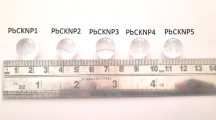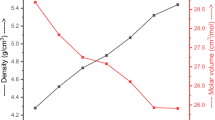Abstract
The attenuation of γ-rays in α-quartz homeotypes is influenced by various factors, including unit cell parameters, intertetrahedral bridging angle, and chemical composition. This study aims to investigate the correlation between these crystal parameters and the attenuation properties of γ-rays in α-quartz homeotypes. Thirteen different crystalline forms of α-quartz homeotypes with varying densities were chosen and analyzed for their shielding properties. Their mass attenuation coefficients (MAC) and linear attenuation coefficients (LAC) were calculated for a range of photons energies using XCOM online software. The results revealed distinct dependencies of MAC and LAC values on incident photon energies and α-quartz homeotypes. They follows the following sequential order in the low and high energy domains:MACGaAsO4 < MACGaO4 > MACBAsO4 > MACAlAsO4 > MACGaPO4 > MACAl0.33Ga0.67PO4 > MACFePO4 > MACPON > MACSi0.56P0.44O1.56N0.44 > MACAlPO4 > MACSiO2 > MACBPO4 > MACBeF2. The GaAsO4 homeotype exhibited the highest MAC values at low incoming photon energies, while the BeF2 compound displayed the least MAC values. The LAC values also demonstrated variations among the homeotypes, with GeO2 (with a = 4.9845 Å, c = 5.6477 Å, ρ = 4.2700 g/cm3, APF = 0.408) exhibiting the highest values. The influence of the intertetrahedral bridging angle and tilt angle on LAC values was investigated, indicating that an increase in the intertetrahedral bridging angle (or a decrease in the tilt angle) led to a decrease in LAC. This study provides valuable insights into the structural-radiation absorption properties of α-quartz homeotypes and their potential applications in radiation shielding, paving the way for the development of novel materials with optimized radiation shielding efficiency.
Similar content being viewed by others
Data Availability
All data generated or analyzed during the study are included in this article.
Change history
18 September 2023
A Correction to this paper has been published: https://doi.org/10.1007/s12633-023-02666-2
References
Chilton AB, Shultis JK, Faw R (1984) Principle of Radiation Shielding, 1st edn. Prentic-Halle, Englewood Cliffs, New Jersey
Verma S, Srivastava AK (2023) Advanced Radiation Shielding Materials: Radiation and Radiological Protection, 1st edn. Elsevier
Hemley R, Jephcoat A, Mao H et al (1988) Pressure-induced amorphization of crystalline silica. Nature 334:52–54. https://doi.org/10.1038/334052a0
Haines J, Cambon O (2004) The effects of pressure, temperature and composition on the crystal structures of α-quartz homeotypes. Z Kristallogr 219:314–323
Dachille F, Dent Glasser LS (1959) High-pressure forms of BPO4 and BAsO4; quartz analogues. Acta Crystallogr 12:820–821
Barz R-U, David F, Schneider J, Gille P (2001) Polymorph stability and phase transitions of trigonal Al1-xGaxPO4 mixed crystals. Z Kristallogr 216:501–508
Goiffon A, Jumas JC, Maurin M, Philippot E (1986) E´tude compare´e a diverses temperatures (173, 293 et 373 0K) des structures de type quartz α des phases MIIIXvO4 (MIII=Al, Ga et Xv=P, As). J Solid State Chem 61:384–396
Xia H-R, Qin Z-K, Yuan W, Liu S-F, Zou Z-Q, Han J-R (1997) Growth and properties of trigonal aluminium gallium orthophosphate single crystals Al1-xGaxPO4. Cryst Res Technol 32:783–788
Halliwell E, Couch C, Begum R, Li W, Maqbool M (2021) Increase in linear attenuation coefficient by changing crystal structure of materials for radiation shielding and biomedical devices safety. Colloids Surf A 622:126646
Brabants L, Reniers B, Cavus H, Paepen J, Vandoren B, Schroeyers W (2022) Computed tomography to evaluate the influence of the internal concrete structure on attenuation coefficients. Radiat Phys Chem 201:110433
Couch C, Halliwell E, Begum R, Ali G, Khan T, Maqbool M (2022) Efficiency enhancement in scintillation detectors by changing the valence-band electron density and crystal structure of the scintillation material. J Appl Cryst 55:615–620
ANSI/ANS-6.4.3 (1991) Gamma Ray Attenuation Coefficient and Buildup Factors for Engineering Materials. American Nuclear Society La Grange Park, IL
Berger MJ, Hubbell JH, Seltzer SM, Chang J, Coursey JS, Sukumar R, Zucker DS (1998) XCOM: photon cross sections database. NIST Stand Ref Database 8:87–3597
Hubbell JH (1993) Review of photon interaction cross section data in medical and biological context. Phys Med Biol 44:R1–R22
Şakar E, Özpolat ÖF, Alım B, Sayyed MI, Kurudirek M (2020) Phy-X/PSD: Development of a user friendly online software for calculation of parameters relevant to radiation shielding and dosimetry. Radiat Phys Chem 166:108496
Kittel C (2005) Introduction to Solid State Physics, 8th edn. John Wiley & Sons, NJ
Ashcroft NW, Mermin ND (1976) Solid State Physics. Saunders College Publishing, NY
Wells AF (1984) Structural Inorganic Chemistry. Clarendon Press, Oxford. ISBN 0-19-855370-6
Pauling L (1940) The Nature of the Chemical Bond and the Structure of Molecules and Crystals, 2nd edn. Cornell University Press, Ithaca
Li G, Sui X, Qin X, Ma Y, Wang K, Wang Q (2016) Structural transformation between bcc and fcc in Fe–Ni nano-particle during heating process. Phys Lett A 380:3500–3504
Chai P, Abramchuk M, Shatruk M (2016) Synthesis, crystal structure, and magnetic properties of giant unit cell inter-metallic R117-Co52+δSn112+γ (R = Y, La, Pr, Nd, Ho). Crystals 6:165
Wei W, Hong Y, Yuan Y, Li Y, Cui K, Zhang T, Jia X, Qin W, Xiaohong Wu (2023) Enhanced wide energy regions gamma ray shielding property for Bi2O3- Gd2O(CO3)2∙H2O/EP composites with strong electron cloud overlap. J Alloy Compd 938:168672
Acknowledgements
Ziad Khattari and Saleh Al-Omari would like to thanks the support from Hashemite University.
Author information
Authors and Affiliations
Contributions
Ziad Khattari: Conceptualization, review & editing, writing manuscript first draft.
Shaaban Shaaban: Assisted in data analysis and drawing the figures.
Saleh Al-Omari: Assisted in data collection & analysis and rearranging the manuscript first draft and wrote the reply to reviewers and edited the final version.
Ragab Elsad: Review & editing, resources;
Yasser Rammah: supervision and Finalized the last version of the manuscript.
All authors read and approved the final manuscript.
Corresponding author
Ethics declarations
Ethics Approval
Not Applicable.
Consent to Participate
Not Applicable.
Consent for Publication
Not Applicable.
Competing Interests
The authors declare no competing interests
Disclosure of Potential Conflicts of Interest
The authors have no relevant financial or non-financial interests to disclose.
Research Involving Human Participants and/or Animals
Not Applicable.
Informed Consent
Not Applicable.
Additional information
Publisher's Note
Springer Nature remains neutral with regard to jurisdictional claims in published maps and institutional affiliations.
Supplementary Information
Below is the link to the electronic supplementary material.
Rights and permissions
Springer Nature or its licensor (e.g. a society or other partner) holds exclusive rights to this article under a publishing agreement with the author(s) or other rightsholder(s); author self-archiving of the accepted manuscript version of this article is solely governed by the terms of such publishing agreement and applicable law.
About this article
Cite this article
Al-Omari, S., Shaaban, S.M., Rammah, Y.S. et al. The Influence of Unit Cell Parameters, Intertetrahedral Bridging Angle and Chemical Composition on the Crystal γ-ray Attenuation of α-quartz Homeotypes. Silicon 15, 7865–7873 (2023). https://doi.org/10.1007/s12633-023-02630-0
Received:
Accepted:
Published:
Issue Date:
DOI: https://doi.org/10.1007/s12633-023-02630-0




